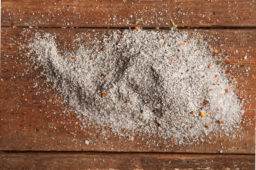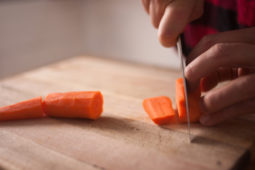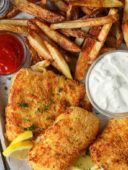Crafting Liberation: Confessions of an Unredeemable Direction-Follower

I’m an unredeemable direction-follower. As a boy, I’d account for the meniscus when measuring water to make Ramen noodles. As a man, I was relentlessly mocked by my wife for my stove-side devotion to the succinct instructions of Mark Bittman (aside: If you only ever own one cookbook–and you should only ever own one cookbook–it should be Bittman’s entirely accurately titled HOW TO COOK EVERYTHING. It’s like the universal Chilton Manual for prepared food).
This, obviously, is the pathology of a man terrified of failure–that I ever wrote anything at all, let alone an entire damn book (let alone several!) is itself a crippled miracle. While DIY is obviously empowering–My stove was broken, now it’s fixed; I did that!–having instructions in hand can really quickly shackle us, as it’s so easy to mistake a good way of doing X for the only way to do X.
I was a willing slave to the ingredients list and the step-by-step.
I finally confronted this at 28. When my son was born I left my job teaching and administering programs at a small private school to be a full-time father. It obviously wasn’t sterling economic judgement to add a human to our household while simultaneously cutting our income in half (or halfish–my wife had the better job and healthcare, which is why I’m the one who stopped working outside in the World of Real People). I was freelance writing and editing (mostly copyediting, really) during that period, but that was only night and nap-time work, and so our budget was tight. Our mortgage was a fixed cost; gas for my wife to drive to work was a fixed cost; as folks with no AC who never let the boiler get the house much above 60, utilities where a fixed cost. When we cut all of the fat from our budget, the only flex point left was the grocery budget. Subsequently, during that first year, I often found myself without an ingredient from the list. This meant a lot of improvisation, and subsequently a lot of discovery.
As it turns out, there’s nothing in a cookbook that’s written in stone. Does it say all-purpose white flour? I’m gonna tell you, cake flour will probably work. Whole wheat will probably work if you add a little extra wet stuff. For something that doesn’t really need to rise–quick bread or cookies, for example–masa harina (a fine cornmeal flour used to make tortillas) will work, as will oats ground up in a food processor. Beer can replace stock in any recipe, and bonus, cheap beer works better here. A striped down “French bread” dough (e.g., 3.5 cups flour, a teaspoon of yeast, a teaspoon or two salt, 1.5 cups water; smash together) will serve as pizza crust, fry bread, buns, rolls, artisanal hand-formed round for a dinner party, or utilitarian sandwich bread. The savvy–and frugal–kitchen technician learns that cookies, scones, and biscuits are all the same thing: sweetened flour-and-water paste with fat added, baked at 375 for 7 to 10 minutes.[1].
This new-found liberation carried over into faking a lot of things as I built and repaired what we couldn’t buy. And, when I started writing Snip, Burn, Solder, Shred, that same attitude wound up in the projects: How can I make this simpler? Cheaper to build? Easier to generalize? And I know I’m not the only DIY writer who takes this attitude.
My point: Every parts list is really a set of suggestions. If there is no danger in making a replacement (i.e., you’re not working with high voltage, high speeds, or high toxicity), then swap in what you’ve got for what you need. Three-quarters of the time it works well enough, and surprisingly often you wind up with something both surprising and awesome.
The rule then, for any project, is this: Do what you can with what you’ve got.[2]
NOTES:
[1] FYI, the formula for cookies|scones|biscuits is 1:2:3, which is the ratio of sweet-stuff to fat-stuff to flour-stuff (by volume). So, for a lil batch of cookies, you can do 1/3 cup sweet-stuff (sugar, brown sugar, honey, maple syrup, cane syrup, or any combination there-of), 2/3 cup fat-stuff (butter or shortening for cookies), and 1 cup flour-stuff. If you use butter, this “cookie” comes out like a shortbread/sugar cookie. Replace butter with eggs and cut back on the sugar, you’ll get biscuits. Use a little egg and a little butter and either more or less sugar? You’ve got scones. Throw in raisins or chocolate chips, charge a couple bucks each, serve it with a cup of burned coffee, and you’re Starbucks.
[2] I was later informed that this is essentially Roosevelt’s Law of Task Planning, whose canonical formulation is: “Do what you can, where you are, with what you have.”
DAVID ERIK NELSON is the author of Snip, Burn, Solder, Shred: Seriously Geeky Stuff to Make with Your Kids. You can find his book in many actual bookstores, order online from Amazon (where it’s on backorder), or get a copy immediately from the publisher (No Starch Press: https://nostarch.com/snipburn.htm)–where you can use the coupon code “SHRED,” save 35%, and get the ebook editions for FREE!
The Kindle edition of his Nebula-nominated novella Tucker Teaches the Clockies to Copulate is now available for immediate purchase and download at Amazon.com
Find David online at davideriknelson.com, or as @SquiDaveo on Twitter.






![How to Make Perfect Salmon Jerky [No Dehydrator Required]](https://www.manmadediy.com/wp-content/uploads/sites/52/2020/11/how-to-make-the-perfect-homemade-salmon-jerky-94084-128x170.jpeg)


